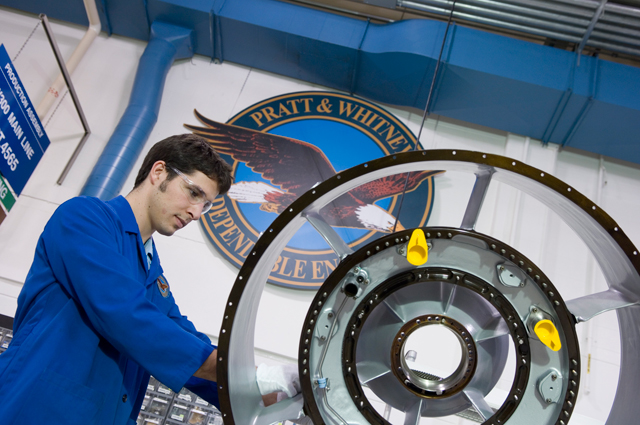These are “exciting times” in the business aviation market for Michael Perodeau, vice-president of corporate and military aviation at Pratt & Whitney Canada. Although the sector has failed to fully recover from the global downturn at the turn of the decade, the Montreal-based manufacturer, one of the oldest brands in business and general aviation, has had a good run of success. Its products will power three in-development types due to enter service over the next four years.
In October 2014, its 15,000lb (67kN)-thrust PW800, based on the same core as the PW1000G geared turbofan that powers several commercial airliners, was confirmed as the exclusive engine for two new Gulfstreams, the G500 and G600 – beating a rival offer from long-time Gulfstream incumbent Rolls-Royce. It was a significant rebound in fortunes for P&WC after the powerplant’s first application, the Cessna Citation Columbus, was cancelled in 2009, leading to the engine programme being suspended.
However, P&WC quietly resumed development and testing, and its efforts were rewarded with the Gulfstream deal. It followed earlier wins on the Cessna Citation Latitude and Dassault Falcon 8X trijet with versions of its 4,700lb to 8,000lb-thrust PW300. Both programmes – the midsize Latitude and the large-cabin 8X, a 7X stretch – will go into service in the next 12 months. The 8X is powered by the PW307D, a version of the 7X’s 307A, while the Latitude’s PW306D1 is a variant of the PW306D on the Citation Sovereign.

Subassembly of the PW306 in Canada
Pratt & Whitney Canada
The PW800 – which completed an unannounced first flight on a Boeing 747SP flying testbed in 2013 and received Transport Canada certification in February – has completed over 3,400h of testing, including 350h on the 747. “In the coming weeks these will continue to accumulate once the Gulfstreams start flying,” says Perodeau. “Once that happens, our task will be mainly about supporting Gulfstream’s flight test programme through to certification. But we are hitting our KPIs [key performance indicators]. These are exciting times,” he says.
P&WC – founded in 1928 as an independent Canadian offshoot of the United Technologies-owned US engine maker, and its small-engine specialist – is now preparing for a production ramp-up of the new PW300-based engines for the 8X and Latitude as both aircraft enter production in the next 12 months or so. For now, P&W is delivering engines to support the flight test programmes. As both engines will run on the same line as the PW307A, there will be a minimum of upheaval as output gathers pace.
The Gulfstream deal consolidates P&WC’s position in the large and ultra-long-range segment, which Perodeau describes as the “most robust” in the business aviation market. “Despite all the various economic challenges, it remains strong,” he says. P&WC entered the large-jet space early this century with the Falcon 2000 and 7X programmes. “Now with the PW800 on the two Gulfstream programmes, we feel we are in a pretty good place,” he says. “There is no reason to believe this segment won’t remain robust.”
By contrast, the very-light to medium segments – where P&WC engines power the Cessna Citation Mustang, the Eclipse 550 and the Embraer Phenoms – have been worse hit. However, Perodeau is confident they can recover. “The safest thing to say is that they have stabilised and the hope is that they will grow in future. The economic indicators have been in the right direction for some while, so it’s a question of what’s holding the market back,” he says, insisting: “It’s a segment we will continue to invest in.”
The mid-2000s saw enormous hype around the potential of very-light jets – at one point the original Eclipse Aviation had an orderbook for around 4,000 PW610F-powered Eclipse 500s, many of them from a new wave of on-demand air taxi start-ups. A confident P&WC supply chain had looked forward to a significant production increase. However, Perodeau claims that “while there were lots of very optimistic projections for thousands and thousands of sales, we didn’t over-capitalise, so we didn’t get left with a lot of unused capacity”.
P&WC – which late last year pledged to invest more than $1 billion on research and development after receiving a $300 million loan from the Canadian government – has a range which extends from the veteran PT6 turboprop engine to the PW800 turbofan, although its Mirabel plant near Montreal will also assemble the Bombardier CSeries’ PW1500G – one of the PurePower geared turbofan family designed by a partnership led by its Connecticut-based Pratt & Whitney sister business.
P&WC, which has 50,000 business and regional jet, helicopter and turboprop engines in service throughout the world, has also talked about long-term plans to develop a 2,000shp (1,490kW) turboprop engine, as well as variants of the PT6 with electronic engine controls. Perodeau acknowledges that the division is “always prepared to expand our power ranges if the right opportunity presents itself”. He adds: “It is just a question of finding the right intersection of business opportunity and technology.”
Source: Flight International



















